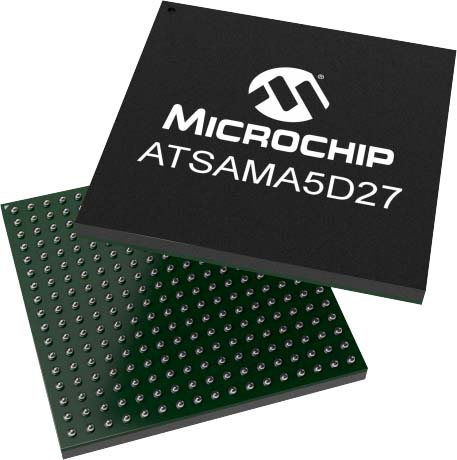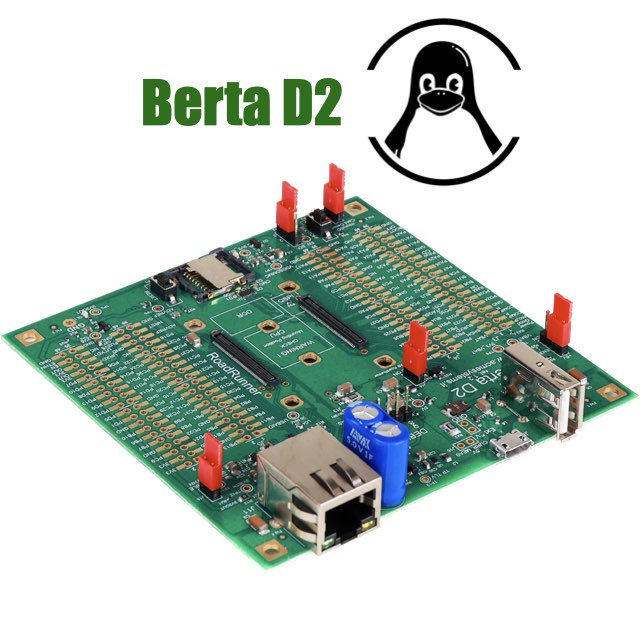Roadrunner technical documentation Buy
RoadRunner - Linux embedded system on module
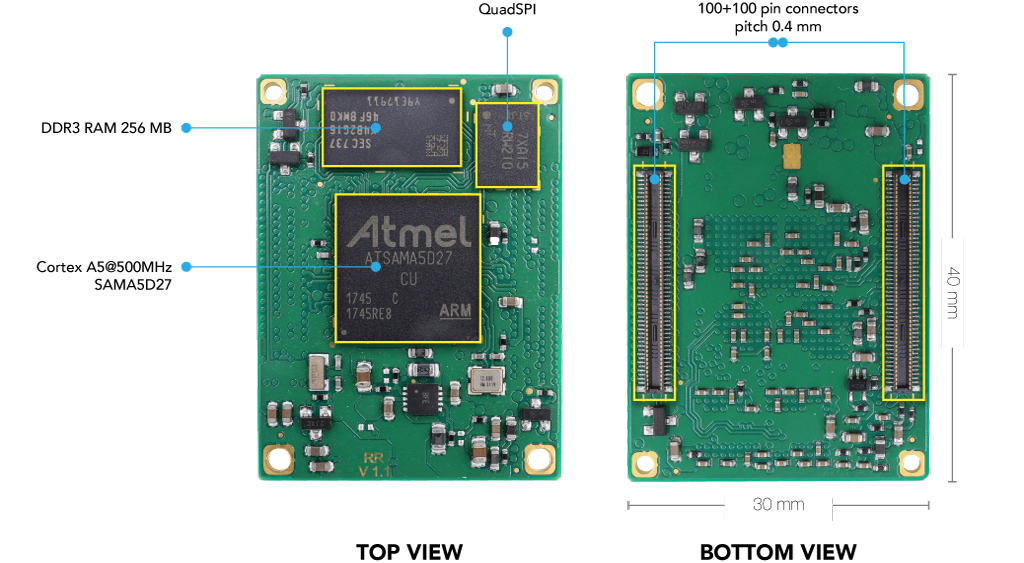
CPU features
- Microchip SAMA5D27 MPU (Cortex A5 single core @500MHz)
- On-the-fly AES encryption/decryption on DDR and QSPI memories
- 32-Kbyte L1 data cache, 32-Kbyte L1 instruction cache
- 128-Kbyte L2 cache configurable to be used as an internal 32 bit single cycle SRAM
- 5 Kbytes of internal scrambled SRAM:
- 1 Kbyte non-erasable on tamper detection
- 4 Kbytes erasable on tamper detection
- 256 bits of scrambled and erasable registers
- Up to seven tamper pins for static or dynamic intrusion detections
- Secure Boot Loader
- RTC including time-stamping on security intrusions
- Programmable fuse box with 544 fuse bits including JTAG protection and BMS
- NAND controller
- ARM NEON (tm) SIMD Media Processing Engine
- Hardware Floating Point Unit
- Hardware cryptography
- SHA: SHA1, SHA224, SHA256, SHA384, SHA512; compliant with FIPS PUB180-2
- AES: 256, 192, 128 bit key algorithm; compliant with FIPS PUB 197
- TDES: two-key or three-key algorithms; compliant with FIPS PUB 46-3
- True Random Number Generator (TRNG); compliant with NIST Special Publication 800-22 Test Suite and FIPS PUBs 140-2 and 140-3
Microchip SAMA5D27 CPU
Read more about the CPU Microchip SAMA5D27 from Microchip web siteSOM features
- RAM: 256 MBytes of DDR3L RAM @ 166MHz
- FLASH: Up to 128 MBytes of QSPI flash memory @ 133MHz
- Extended temperature range: -40°C to +85°C
- Small form factor: 40 x 30 (3.5mm height over carrier board)
- Weight: 5g
- 10 layers VIPPO technology PCB
- Single power supply at 3.3 Volt DC
- Ultra Low-power mode with fast wakeup capability
- Low-power Backup mode with 5-Kbyte SRAM and SleepWalking (tm) features
- Wakeup from up to eight wakeup pins, UART reception, analog comparison
- Extended Backup mode with DDR in Self-Refresh mode
- Low power consumption:
- 100% CPU (memtester): 120mA @ 3.3V (396mW)
- idle (at Linux prompt): 60mA @ 3.3V (198mW)
- Standby mode (resume in 159ms): 5.3mA @ 3.3V (17mW)
- Suspend To RAM mode (resume in 1.5s): 3mA @ 3.3V (10mW)
- Backup mode (poweroff with RTC and event wakeup, resume <14s with Debian; <6s with Buildroot): 0mA @ 3.3V (0mW)
- Read more about the RoadRunner power consumption
- Low EMI (multiple ground planes and impedance controlled tracks)
Declarations of conformity
Signals on pins
Two Hirose 6Gbps 100-pin connectors 0.4 mm pitch, with all the CPU signals:
- 10/100 Mbit/s Ethernet MAC with IEEE1588 Precision Time Protocol (PTP)
- RGB interface @ 24 bit for LCD TFT
- Resistive and capacitive touch panel interface
- Synchronous Serial Controllers SSC/I2S (up to 2)
- TWI compatible I2C interface (up to 7 buses) up to 400 Kbits/s supporting I2C and SMBUS
- SPI bus interface (up to 7 buses)
- Quad Serial Peripheral Interfaces QSPI (up to 2)
- One Stereo Class D audio amplifier integrated
- Peripheral Touch Controller PTC with up to 8X-lines and 8Y-lines (64-channel capacitive touch)
- Pulse Density Modulation Interface Controller PDMIC (digital microphone)
- Two master CAN-FD MCAN controllers with SRAM-based mailboxes
- GPIO lines (up to 128)
- A/D converter @ 12 bit (up to 12)
- Serial ports (up to 10: five USART and five UART)
- One additional Rx only UART in backup area RXLP
- One analog comparator ACC in backup area
- 2 high-speed USB Host, or 1 USB Host and 1 USB device
- 1 high-speed Inter-Chip HSIC USB port interface
- Two high-speed memory card hosts (SDIO, SD or MMC):
- SDMMC0: SD 3.0, eMMC 4.51, 8 bits
- SDMMC1: SD 2.0, eMMC 4.41, 4 bits only
- ITU-RBT.601/656/1120 Image Sensor Controller ISC supporting up to 5M-pixel sensors
- Two 3-channel 32-bit Timer/Counters TC , supporting PWM modes (up to 6 out)
- One full-featured 4-channel 16-bit PWM controller
- Programmable clock (up to 3)
- JTAG port
- Debug serial port
- Battery input for internal RTC, backup area and backup RAM
Software features
- This board is fully supported inside the Linux Kernel main stream http://www.kernel.org. Thanks to this fact it is possible to try also the very latest Kernel releases. On this site we'll release up to the latest longterm versions.
- All the kernel drivers are fully open source and available directly on the official Linux repository.
- On RoadRunner (Microchip SAMA5D27) technical documentation is available the step-by-step documentation to install Linux from scratch.
- Ready-to-use binary images of Debian and Buildroot Linux distribution are available on Download binary images for RoadRunner SOM page
- Ready-to-use microSDs are also available on our Store
Berta D2 - Development kit
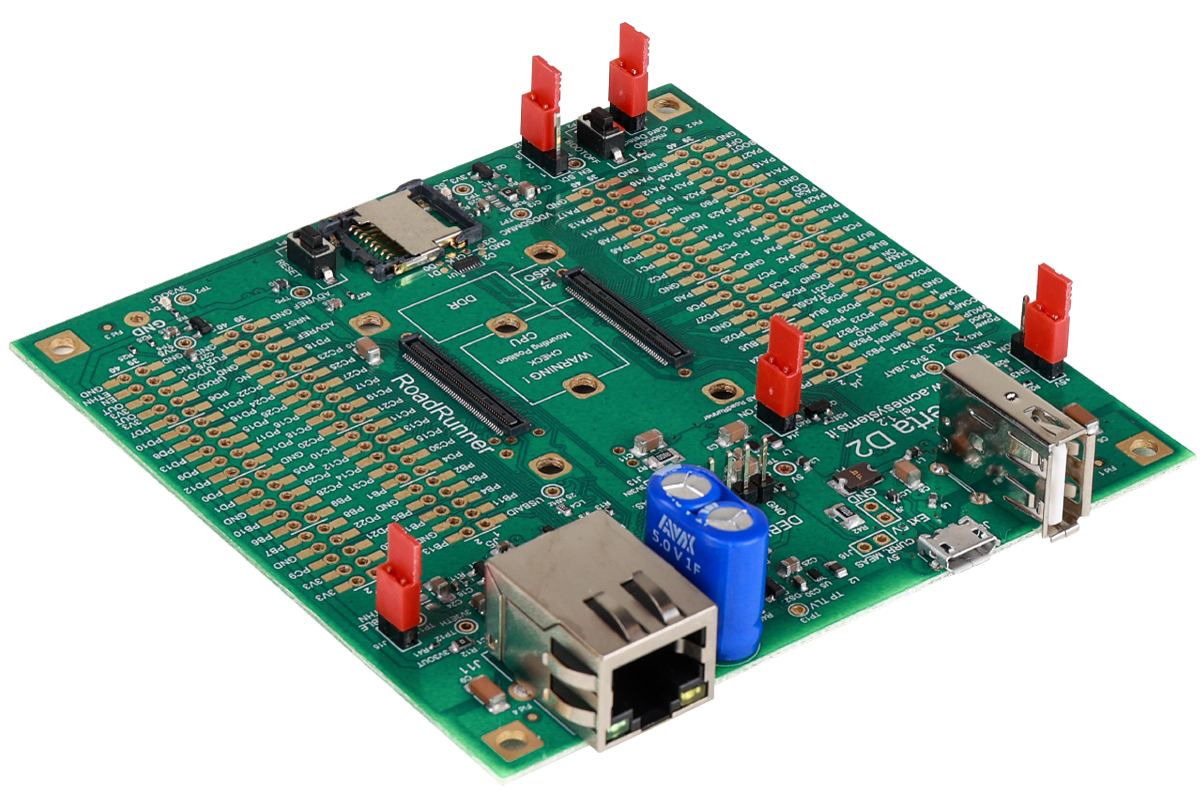
Features
- Placement for one RoadRunner SoM
- 1 USB host port
- 1 USB device port on microUSB used also for 5 VDC power in
- 1 Ethernet port with etherney phy
- 1 MicroSD socket
- Serial debug port pins
- HSIC signals on pad
- Test points for power consumption measurements @5V and @3.3V
- 4 placements for 20x2 pin headers or sockets 2.54mm pitch
- 1 Farad supercap for RTC and backup memory circuit
- Reset push-button
- Boot-off push-button for programming the onboard Quad SPI
Form factor compatible with Teko Tekal 31.29/30 enclosure
The Berta D2 board can be used as
- Development kit to evaluate the RoadRunner features
- Fast prototyping system for your application using it as a mother board and the Teko Tekal 31.29/30 enclosure as enclosure.
- Hardware reference design for your custom project based on RoadRunner SOM
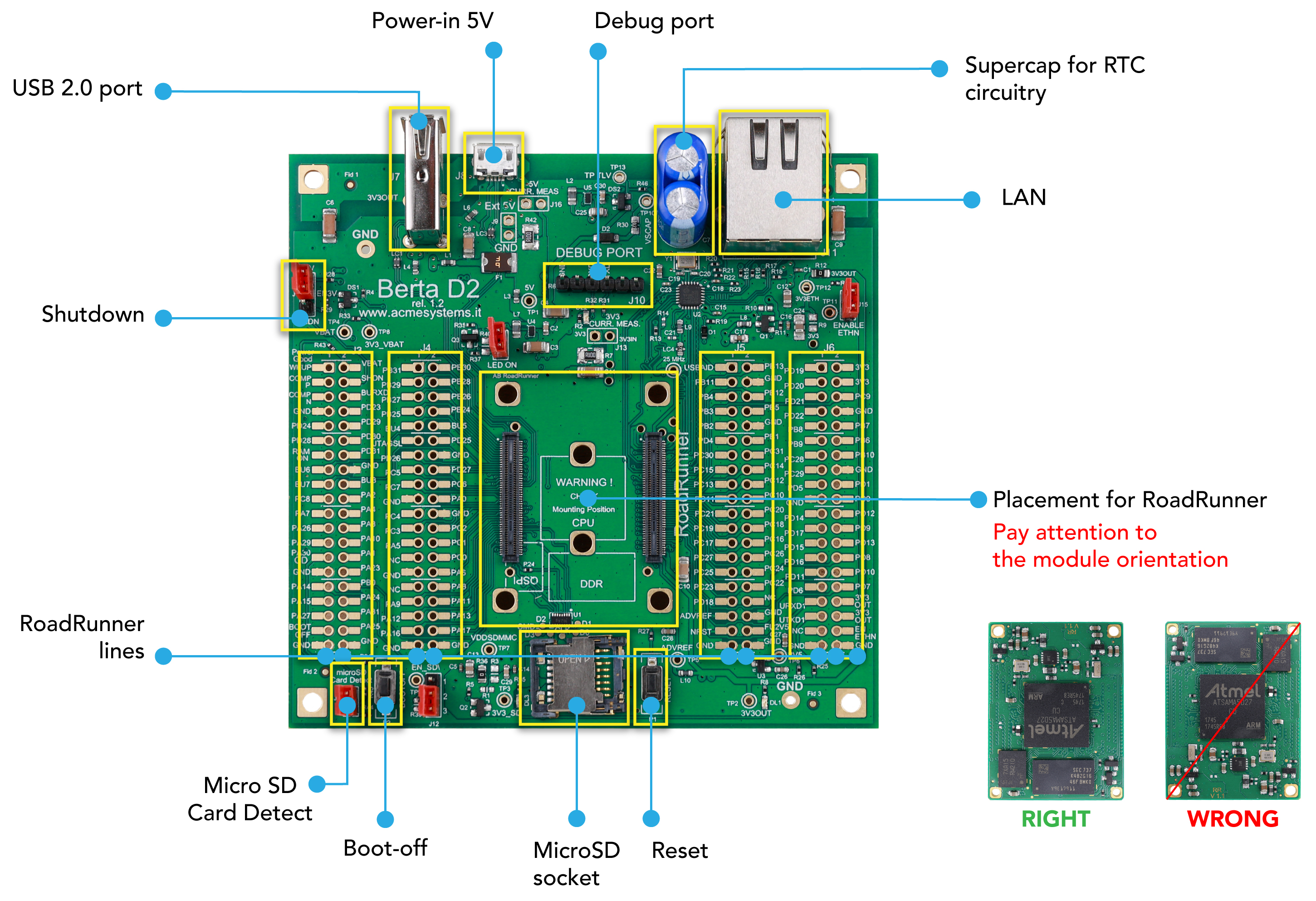
HSIC port
High-speed Inter-Chip HSIC USB port interface
USB 2.0 host port
High-speed USB 2.0 Host
Power-in 5V - microUSB client port
Use this port to power supply the board using a microUSB 5VDC wall adapter or an USB port of your PC. In this case the board is announced as an USB device. Using the SAM-BA utility will be possible to write on the QuadSPI memory.
Debug port
On this strip is possible to plug an USB to serial converter like the Debug Port Interface or USB to serial cable
Supercap for RTC circuitry
This supercap is instead of a backup battery to mantain the Real Time Clock when there is no main power supply. The RTC circuitry is embedded inside the RoadRunner MCU.
10/100 Mbit/s LAN port
10/100 Mbit/s Ethernet port. Please note that the RoadRunner doesn't have an its own MAC address. You have to add a MAC address chip like a Microchip AT24MAC402 on your carrier or save a MAC number on the Linux rootfs and provide it during the boostrap.
RoadRunner lines
Placements for 4 strip at 20x2 pins pitch 2.54mm. On this vias are available all the RoadRunner lines not used by the Berta D2. Each line is marked with the name of GPIO line or the type of signal.
Placement for RoadRunner SOM
Two Hirose 6Gbps 100-pin connectors 0.4 mm pitch where to plug the RoadRunner SOM. Pay attention to the module orientation to avoid SOM damages.
MicroSD socket
Placement for the microSD with Linux. Download the microSD demo image from this repository or buy a ready to use industrial microSD from Acme eShop. Up to 128 GB microSD can be used.
Push-buttons
- BOOTOFF Keep pressed this button during the reset or power-on to disable the QuadSPI memory
- RESET Board reset
Jumpers and test point
- J1 Shutdown__
- J12 EN SD\
- Position 1-2: microSD power controlled by external signal
- Position 2-3: microSD power always on
- J13 CURR.MEAS The voltage measured on these pins is directly proportional to the absorbed current on 3V3. (1 mV = 10 mA)
- J14 LED ON Open this jumper to turn-off all the led on board
- J15 ENABLE ETHN Open this jumper to turn-off the ethernet port
- J16 CURR.MEAS The voltage measured on these pins is directly proportional to the absorbed current on 5V. (1 mV = 10 mA)
- TP5 ADVREF Analog to digital interface voltage reference
- VBAT Voltage on RTC backup Battery pin
- VBAT_SC Voltage on Super CAP
- The voltage measured on these pins is directly proportional to the absorbed current on VBAT line (1 mV = 1 uA)
- 3V3ETH Voltage on ethernet circuitry
- 2V5 Voltage on 2V5 line
- TP7 VDDSDMMC
- 3V3 VCC of logic
- Ext 5V Power supply incoming from the microSD connector
- 5V Main VCC
- GND Ground signal
For more in-depth information on the signals available on the Berta Board please check its schematic:
Related products

- CPU Microchip SAMA5D27
- Cortex A5 @ 500 MHz
- Low power consumption:
Suspend to RAM mode 10mW
Full speed: 396mW - Debian, Buildroot and Yocto Linux
- Fully open source drivers
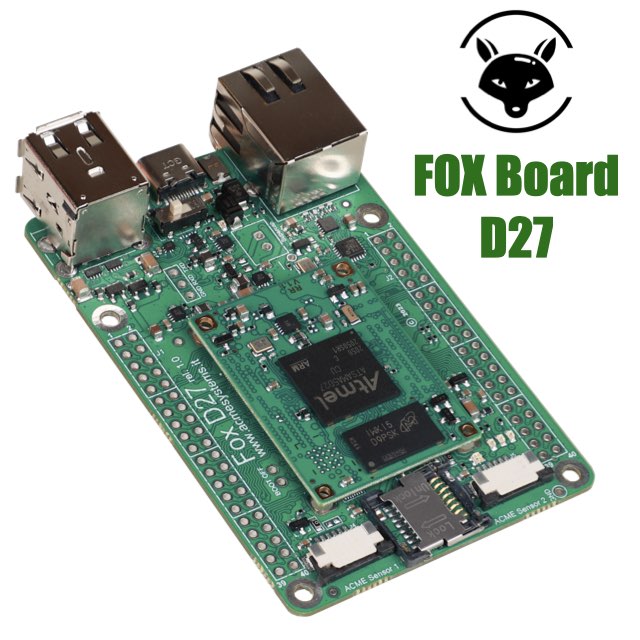
- Low power consumption
- Two USB Host 2.0 ports (one configurable as USB client on the USB-C connector)
- One 10/100 Mbit/s Lan port
- 2 Acme Sensor ports
- Huge set of GPIOS, SPI, I2C and serial lines
